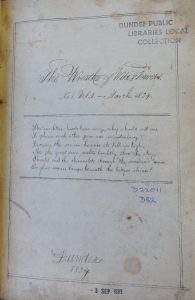
Overview
This magazine is in the handwriting of William Gardiner (1809-1852), aged 25 when the first issue was compiled. Gardiner’s work appears under the pseudonym Sylvanus. All of the contributors appear under classically alluding pseudonyms, including Daphnus, Corydon and Damon, but no others have been traced.
Gardiner was a poet and amateur botanist who would become well-regarded in the natural science circles of 19th century Scotland. He left school at an early age and was apprenticed as an umbrella-maker, a trade he continued to work in while pursuing literary and scientific interests outside of work. He also combined these interests by including poems on the moral and spiritual meanings of plants in some of his botanical works, including his most popular, The Flora of Forfarshire (Dundee: McCosh, Park & Drewar, 1848).
Gardiner’s interest in poetry began early in life, likely inspired by his father, who had published two collections of poetry during Gardiner’s childhood. In his teens, he kept a “Literary Scrap Book and Poetical Miscellany,” in which he transcribed copies of poetry from periodicals, books and other sources. While there is no indication this was intended for an audience beyond himself, it may have inspired him to undertake a similar project with interested friends.
All the issues of The Wreath of Wild Flowers contain a list of readers, and later, addresses are also given. The “W. Jackson” listed in the first issue may be tailor-turned-naturalist William Jackson (or his son of the same name, who would be fourteen at the time), both of whom were part of the same social circles as Gardiner and also became respected self-educated scientists. The authors’ links to natural history circles are evident in many ways. The back pages contain updates on the progress of “The Amateur Naturalist’s Repository,” either inviting submissions or noting it is on hiatus due to having too many mosses and insects to collect.
The second issue notes that it is “requested to be kept particularly clean,” and that readers may keep it for three days. By the third issue in 1836, the allocated time has been reduced to two days. This issue also lists street addresses for its readers. They are all based in central Dundee, often in industrial areas like the Scouringburn, suggesting a mainly working-class readership. Despite the warning, all the extant issues have been subjected to some minor spillages at some point.
Name of Club, Society or Group That Produced the Magazine
(‘Private distribution amongst small group of readers’) (Dundee)
Date of Existence
1834?-1836?
Date of Magazine
1(1)-1(3), Mar. 1834-Apr. 1836
Number of Issues
3
Manuscript/Published Magazine
Manuscript
Contents and Contributions
Essays; Magazine Rules; News (local branches of society); Poems (original); Title page
Repository
Dundee District Central Library, The Wellgate
Reference
D22011
Additional Notes
See also Dundee Natural History and Literary Magazine, and Gems of Poesy.
These magazines were collected in the 1860s by A.C. Lamb, a Dundee temperance hotelier. Many of the societies represented met on premises owned by either himself or, in earlier decades, in his father Thomas’ coffee house. Lamb was often involved in society life himself, and his collection of over 450 boxes covers a wide range of material relating to literature, poetry, culture and politics in Victorian Dundee. For more information on this material, please contact local.history@leisureandculturedundee.com.
